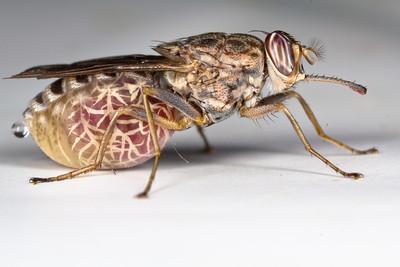In some instances, it was unintentional; in other cases, we ate them down to a protected species. The current plight of the Koala draws our concern; the end of the poliovirus, not so much. Consider the case of an insect that has stunted the development of nations and blighted the lives of people – the Tsetse fly.
The Tsetse fly is an obligate parasite feeding on the blood of vertebrates. It acts as an insect carrier for a protozoan, Trypanosoma brucei, the actual cause of "sleeping sickness" in both humans and animals.
Despite what you might think, the ascension of the tsetse fly to a native-born killer was serendipitous, in a bad way. In 1887, the Italians were waging war with Somalia and purchase cattle from India that were infected with the rinderpest virus. The virus subsequently decimated 80-90% of the cattle in sub-Saharan Africa, which in turn lead to a famine killing a third of Ethiopia's population and two-thirds of the Masai of Tanzania. The loss of the Masai, who nomadically raised cattle, combined with drought, to allow the rapid multiplication of a plant, considered a weed, the thornbush – a comforting home to tsetse flies whose numbers grew as rapidly as the thornbush.
Those lands, which include the Serengeti and Okavango Delta, were rapidly repopulated by wild mammals, but the raising of cattle on those lands was far more difficult. By the early part of the twentieth-century, sleeping sickness had turned those areas into a land, "empty of people and full of game animals" – it seems what we perceive today as the "natural form" of the Serengeti is only 100 years old.
Today, Tsetse flies and their protozoan companion make it difficult if not impossible to farm large regions of the continent, of the 39 countries with these flies, 32 are low-income, food deficient, and 29 are "least developed." The Democratic Republic of the Congo is the site of most infections. Antibiotics have reduced deaths from roughly 13,000 in 1990 to 3700 in 2015. It is classified as a neglected tropical disease.
An African wide initiative, the Pan African Tsetse and Trypanosomiasis Eradication Campaign (PATTEC), was initiated in 2000. While the goal was to eliminate the protozoan disease, in the absence of an effective vaccine, the effort was expended on removing the Tsetse fly vector. Among the techniques are the use of insecticides alone or impregnated into targets or cattle, fly traps, and the introduction of a large number of sterile flies. The latter technique has been used successfully for treating the Mediterranean fruit fly and eliminated the tsetse fly in Zanzibar.
Should we eliminate all tsetse flies?
The wholesale elimination of these creatures, which arguably only became problematic after the human intervention of the Italians, raises an ethical dilemma. The strongest, most visceral response, is that they are killing us, and like pathogenic bacteria and viruses, they have got to go. But perhaps there is a lesson to be learned from antimicrobial resistance; that these species "fight back" and the ensuing battle can have further unintended consequences. And the real target is not the fly, it is their protozoan companions. We permit individuals to opt-out of vaccinations, allowing them to be carriers, and no one is suggesting that they be "removed with extreme prejudice;" at best, they may be isolated. Perhaps we should seek to more surgically remove the Tsetse flies causing us the most significant disruption and leave the others alone.
Animal rights are a human enterprise, just as all ethical dilemmas are seen through human eyes. I will abide by the decision of those most impacted, the sub-Saharan Africans. But the question does raise interesting questions. Can we simply accept our role as just a part of a greater ecosystem, or do we insist that our survival comes first? And if it is the latter, are there ways of surviving that are less harsh?
Source: The Ethics of Eliminating Harmful Species: The Case of the Tsetse Fly. BioScience DOI: 10.1093/biosci/biy155




